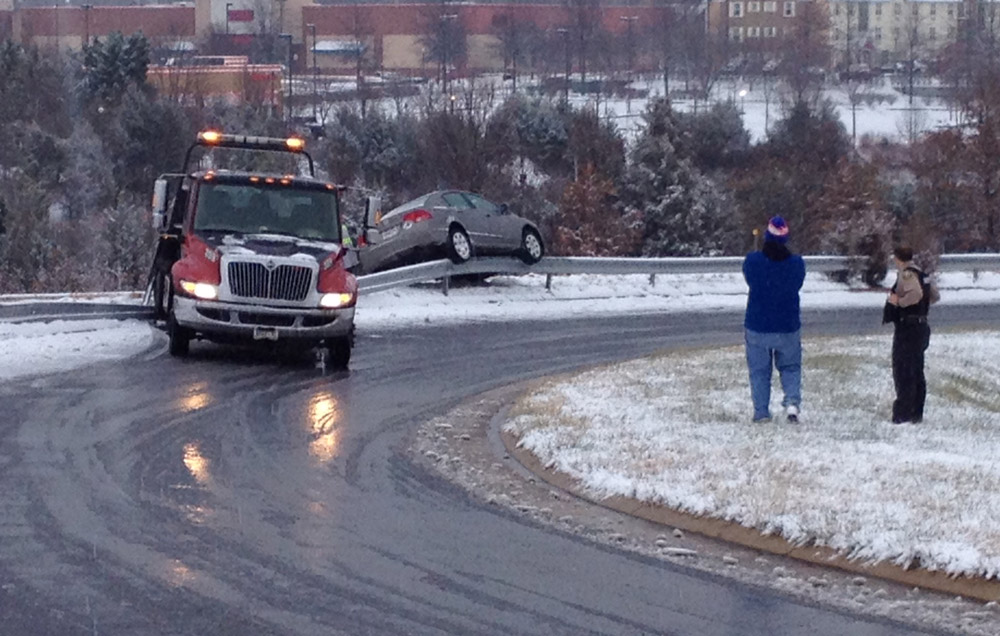WASHINGTON — Whether a few flurries are falling from the sky or its blizzard-like conditions outside, the safest choice is to stay put and stay off the roads. However, not driving is not always an option.
If you do have to get behind the wheel in the snow, here are a few tips from WTOP’s traffic experts to ensure your trip is as safe as possible.
Don’t drive with your hazards on
You may think you’re doing other cars a favor by flipping on your flashers while driving slowly in the snow, but really, it just causes confusion.
“Hazards are meant to be used when your car is stopped, if you’re broken down somewhere so that somebody will see that you’re stopped and will be able to go around you,” says WTOP’s Bob Immler.
“It’s very confusing for other drivers if you’re actually moving with your hazards on — unless you’re about to break down or something like that.”
Driving with your hazards on also means you can’t use your turn signal, which takes away your ability to alert other drivers of intentions to turn or change lanes.
WTOP’s Bob Marbourg says the one time it’s OK to drive with your hazards on is to warn others that you are going significantly slower than the flow of traffic. However, in winter weather conditions, most cars on the road will be traveling at a reduced speed.
“It’s not necessary and it’s not productive,” Marbourg says. “It really is there to designate something that is moving at an entirely different speed from everybody else.”
Turn the high beams off
It’s not always easy to see clearly in snow and sleet, but turning on your high beams will only make it worse. Immler says similar to driving with your high beams on in the fog, the bright lights will just illuminate the snow.
However, Marbourg adds that the high beams do come in handy if you’re driving in highly populated pedestrian areas or in neighborhoods with crosswalks, since modern low beams shine mostly on the road ahead.
Ignore advice to “get an early head start”
Getting an early start to avoid winter weather conditions isn’t always the best choice, Marbourg says. Especially if that earlier-than-normal start has you driving in the dark when you’re not used to it.
“Unless you drive early in the morning on a regular basis, unless you get out on the road early in the morning and you know the range of hazards that are out there, somebody getting an early start before the sun comes up, you can’t see what’s ahead of you,” Marbourg says.
A patch of ice could look like a puddle, and branches and other hazards could be blocking the road. Marbourg’s best piece of advice is to sit tight and leave when you’re used to driving.
“Delay your departure until you can look ahead and actually get a sense of what is on the roadway in front of you,” he says.
In fact, ignore the clock altogether
Larry King once said, “In baseball, the clock is irrelevant.” Marbourg says in winter weather conditions, the same rule applies.
“You’re not in a rush to get there in any one time; your goal is to arrive safely,” he says.
In fact, he even suggests putting a piece of tape across the clock on the instrument panel and ignoring time, altogether.
Don’t ask your front wheels to do too much
Marbourg says there was a time when most cars and trucks had rear-wheel drive, meaning the power went to the back wheels and the front wheels handled the steering. Now, he says, virtually all cars on the road are front-wheel drive, four-wheel drive or all-wheel drive.
What this means is that a lot of the work falls on the front wheels, and this can be difficult in dangerous weather situations.
“When you ask the front wheels and tires to do several things at once on slippery pavement, they’re not going to be able to accomplish all of them,” Marbourg says.
Therefore, in winter weather, do everything as gently as possible.
“If you’re asking your car to turn, slow down before you ask it to turn,” he says. “If you get on the breaks hard and the wheels stop turning, then they’re not going to be effective at steering.”
Drive slowly, anticipate what’s ahead and do everything gradually, he adds.
More Tips for Driving in Snow and Ice
Driving safely on icy roads
- Decrease your speed and leave yourself plenty of room to stop. You should allow at least three times more space than usual between you and the car in front of you.
- Brake gently to avoid skidding. If your wheels start to lock up, ease off the brake.
- Turn on your lights to increase your visibility to other motorists.
- Keep your lights and windshield clean.
- Use low gears to keep traction, especially on hills.
- Don’t use cruise control or overdrive on icy roads.
- Be especially careful on bridges, overpasses and infrequently traveled roads, which will freeze first. Even at temperatures above freezing, if the conditions are wet, you might encounter ice in shady areas or on exposed roadways like bridges.
- Don’t pass snow plows and sanding trucks. The drivers have limited visibility, and you’re likely to find the road in front of them worse than the road behind.
- Don’t assume your vehicle can handle all conditions. Even four-wheel and front-wheel drive vehicles can encounter trouble on winter roads.
If your rear wheels skid…
- Take your foot off the accelerator.
- Steer in the direction you want the front wheels to go. If your rear wheels are sliding left, steer left. If they’re sliding right, steer right.
- If your rear wheels start sliding the other way as you recover, ease the steering wheel toward that side. You might have to steer left and right a few times to get your vehicle completely under control.
- If you have standard brakes, pump them gently.
- If you have anti-lock brakes (ABS), do not pump the brakes. Apply steady pressure to the brakes. You will feel the brakes pulse — this is normal.
If your front wheels skid…
- Take your foot off the gas and shift to neutral, but don’t try to steer immediately.
- As the wheels skid sideways, they will slow the vehicle and traction will return. As it does, steer in the direction you want to go. Then put the transmission in “drive” or release the clutch, and accelerate gently.
If you get stuck…
- Do not spin your wheels. This will only dig you in deeper.
- Turn your wheels from side to side a few times to push snow out of the way.
- Use a light touch on the gas, to ease your car out.
- Use a shovel to clear snow away from the wheels and the underside of the car.
- Pour sand, kitty litter, gravel or salt in the path of the wheels, to help get traction.
- Try rocking the vehicle. (Check your owner’s manual first — it can damage the transmission on some vehicles.) Shift from forward to reverse, and back again. Each time you’re in gear, give a light touch on the gas until the vehicle gets going.
Sources: National Safety Council, New York State Department of Motor Vehicles, Washington State Government Information & Services







